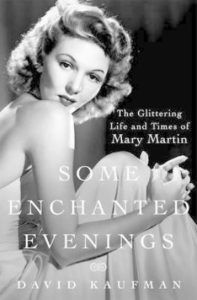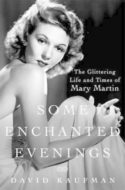Book Review: Some Enchanted Evenings: The Glittering Life and Times of Mary Martin
 Some Enchanted Evenings: The Glittering Life and Times of Mary Martin
Some Enchanted Evenings: The Glittering Life and Times of Mary Martin
David Kaufman
New York, NY: St. Martin’s Press, 2016
ISBN 978-1250031754
420 pp.
David Kaufman brings readers a lively new journey through the career and personal life of an iconic star who enchanted audiences for decades both on stage and via the small screen, though often to the detriment of her family life. As far as his extensive research could lead him, Kaufman arguably offers the fullest portrait of Mary Martin to date.
Martin, born in 1913 Weatherford, Texas, sang and taught dance in her hometown. Her brief marriage to high school football star Ben Hagman produced son Larry of future Dallas fame, but Martin would leave her child to her mother’s care on her way to California for fame and fortune.
Her hard road of auditions and less-than-glorious films finally resulted in discovery by Oscar Hammerstein II and later, through Cole Porter’s 1938 Leave It To Me, thanks to which Mary Martin became an overnight Broadway sensation with her inimitable rendition of “My Heart Belongs to Daddy”. To coin a cliché, she never looked back.
From there, the world was treated to Martin’s South Pacific, Annie Get Your Gun (the national tour), Peter Pan (both on stage and television), The Sound of Music and I Do! I Do!, albeit with a few significant failures along the way, her multiple Tony Awards notwithstanding. She also found a comfortable niche in television, with, for example, her live-to-kinescope reprises of Peter Pan becoming perennial classics.
In 1940, Martin married Richard Halliday, who not only fathered daughter Heller, but also became his wife’s manager, and, arguably, her unyielding protector from all things disagreeable in her life. (Halliday was also alcoholic and homosexual.) As Kaufman details, Martin’s laser-like devotion to her career, coupled with Halliday’s personal and professional dominance, would cause considerable family turmoil, including periodic estrangement from her son who struggled to find his place with his distant mother and stepfather. Halliday’s death in 1973 brought new uncertainty to Martin’s life, leading to some ill-advised career choices. Mary Martin died of cancer in 1990.
In his engrossing narrative, Kaufman skillfully integrates his own research with material from Martin’s 1976 memoir The Heart Belongs and Larry Hagman’s 2001 autobiography Hello Darlin’, plus reminiscences of numerous Martin employees, co-stars, and associates, most of whom vouch for her personal goodness and love for her audiences. The end result is a multi-faceted portrait of a more complex woman than her pristine stage image may have indicated.
As for the lingering question of Martin’s sexuality: Kaufman reveals that, surprisingly, one of the few books Martin read in her youth was the LGBT classic The Well of Loneliness. And her deep friendship with actress Janet Gaynor always inspired knowing nods and raised eyebrows. However, while never shying away from the issue, Kaufman offers no irrefutable evidence that Martin was ever indeed a lesbian.
Thanks to David Kaufman and his blend of admiration and honesty, we are reintroduced to a remarkable woman who was Broadway to multiple generations and, like her beloved Nellie Forbush, a “cockeyed optimist” to the last.
Catherine Ritchie
Dallas (TX) Public Library

